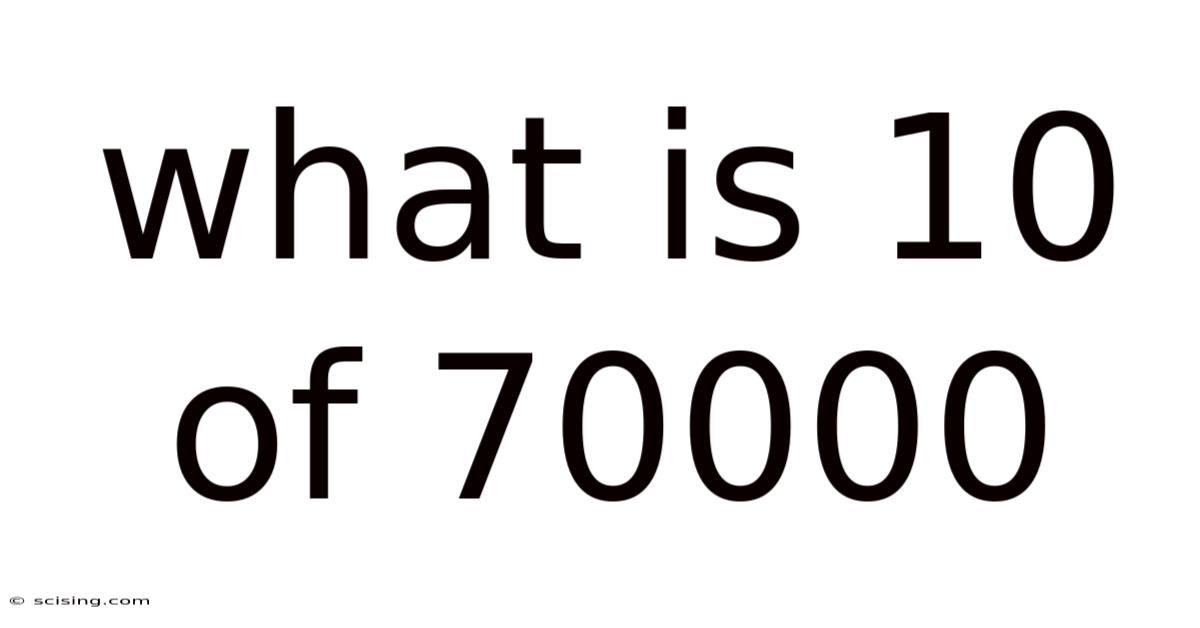What Is 10 Of 70000
scising
Sep 10, 2025 · 4 min read

Table of Contents
What is 10/70000? Understanding Fractions, Decimals, and Percentages
This article will delve into the seemingly simple question: "What is 10/70000?" While the calculation itself is straightforward, understanding the underlying concepts of fractions, decimals, and percentages, and their real-world applications, is crucial. We'll explore the different ways to represent this fraction, analyze its magnitude, and look at examples to illustrate its significance. This comprehensive guide aims to provide a solid understanding for anyone, from students brushing up on their math skills to professionals needing a quick refresher.
Understanding Fractions
A fraction represents a part of a whole. It's expressed as a ratio of two numbers: the numerator (top number) and the denominator (bottom number). In our case, 10/70000, 10 is the numerator and 70000 is the denominator. This means we are considering 10 parts out of a total of 70000 parts.
Fractions can be simplified by finding the greatest common divisor (GCD) of the numerator and denominator and dividing both by it. Let's simplify 10/70000:
The GCD of 10 and 70000 is 10. Dividing both the numerator and denominator by 10 gives us:
10 ÷ 10 = 1 70000 ÷ 10 = 7000
Therefore, the simplified fraction is 1/7000. This means that 10/70000 and 1/7000 represent the same value. Simplifying fractions makes them easier to understand and work with.
Converting Fractions to Decimals
To convert a fraction to a decimal, we divide the numerator by the denominator. In our simplified fraction, 1/7000:
1 ÷ 7000 = 0.000142857...
The result is a decimal number. Notice the ellipsis (...); this indicates that the decimal representation is a non-terminating, repeating decimal. This means the decimal goes on forever, with a repeating sequence of digits. For practical purposes, we often round the decimal to a certain number of decimal places. Rounding to five decimal places, we get 0.00014.
Converting Fractions to Percentages
A percentage is a fraction expressed as a part of 100. To convert a fraction to a percentage, we multiply the decimal equivalent by 100 and add the percent sign (%).
Using our decimal value of 0.00014:
0.00014 x 100 = 0.014%
Therefore, 10/70000 is approximately 0.014%.
The Magnitude of 10/70000
Understanding the magnitude of 10/70000 is crucial. This fraction represents a very small portion of the whole. It's less than one-thousandth (0.001) of the total. To put it in perspective:
- Imagine 70,000 marbles. 10/70000 represents only 10 of those marbles.
- Consider a population of 70,000 people. 10/70000 represents only 10 individuals out of that population.
This small magnitude highlights the importance of understanding the context in which this fraction appears. In some situations, such a small fraction may be insignificant, while in others, it could be crucial.
Real-World Applications
Let's explore some real-world scenarios where a fraction like 10/70000 might arise:
-
Statistical Analysis: Imagine conducting a survey of 70,000 people. If 10 respondents answer a particular question in a certain way, the fraction 10/70000 represents the proportion of respondents with that particular response. This small percentage might be statistically insignificant, requiring further investigation or larger sample sizes.
-
Manufacturing Defects: In a manufacturing process producing 70,000 units, if 10 units are found to be defective, the fraction 10/70000 represents the defect rate. This low defect rate might be acceptable depending on industry standards, but it signals a need for ongoing quality control.
-
Financial Calculations: In finance, a fraction like 10/70000 might represent a small portion of a large investment or a minute change in a stock price. While individually small, these tiny changes can accumulate over time.
-
Scientific Measurement: In scientific experiments involving large datasets or extremely precise measurements, a fraction like 10/70000 could represent a subtle difference between two measurements, requiring careful analysis and interpretation.
Frequently Asked Questions (FAQs)
Q: Can 10/70000 be further simplified?
A: Yes, as shown earlier, it simplifies to 1/7000.
Q: What is the decimal equivalent of 1/7000?
A: The decimal equivalent is approximately 0.000142857... This is a non-terminating, repeating decimal.
Q: What is the percentage equivalent of 10/70000?
A: The percentage equivalent is approximately 0.014%.
Q: Is 10/70000 a significant fraction?
A: The significance of 10/70000 depends entirely on the context. In many situations, it represents a very small and insignificant portion. However, in others, even such a small fraction can be important.
Q: How can I calculate 10/70000 using a calculator?
A: Simply enter 10 ÷ 70000 into your calculator.
Conclusion
Understanding the fraction 10/70000, its decimal and percentage equivalents, and its magnitude is essential for various applications. While the calculation is simple, comprehending the underlying concepts of fractions, decimals, and percentages, and their significance in different contexts, is crucial. This knowledge empowers us to interpret data, make informed decisions, and navigate a world filled with numerical information. Remember to always consider the context when evaluating the importance of any fraction, no matter how small it may appear. The ability to easily convert between fractions, decimals, and percentages is a vital skill in various fields, highlighting the importance of mastering these fundamental mathematical concepts.
Latest Posts
Latest Posts
-
Relative Location Ap Human Geography
Sep 10, 2025
-
New Frontier Us History Definition
Sep 10, 2025
-
Annabel Lee Summary By Stanza
Sep 10, 2025
-
Lewis Dot Structure For Co3
Sep 10, 2025
-
Use Omnipotent In A Sentence
Sep 10, 2025
Related Post
Thank you for visiting our website which covers about What Is 10 Of 70000 . We hope the information provided has been useful to you. Feel free to contact us if you have any questions or need further assistance. See you next time and don't miss to bookmark.